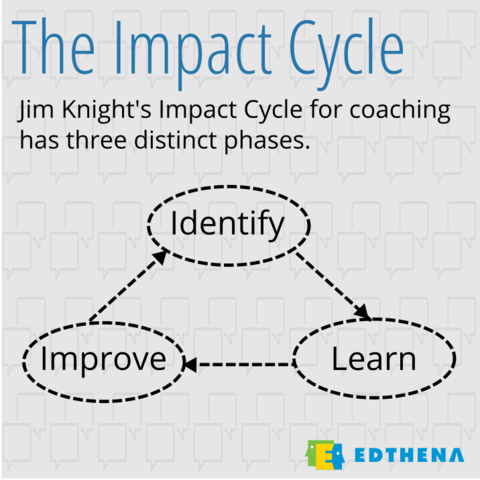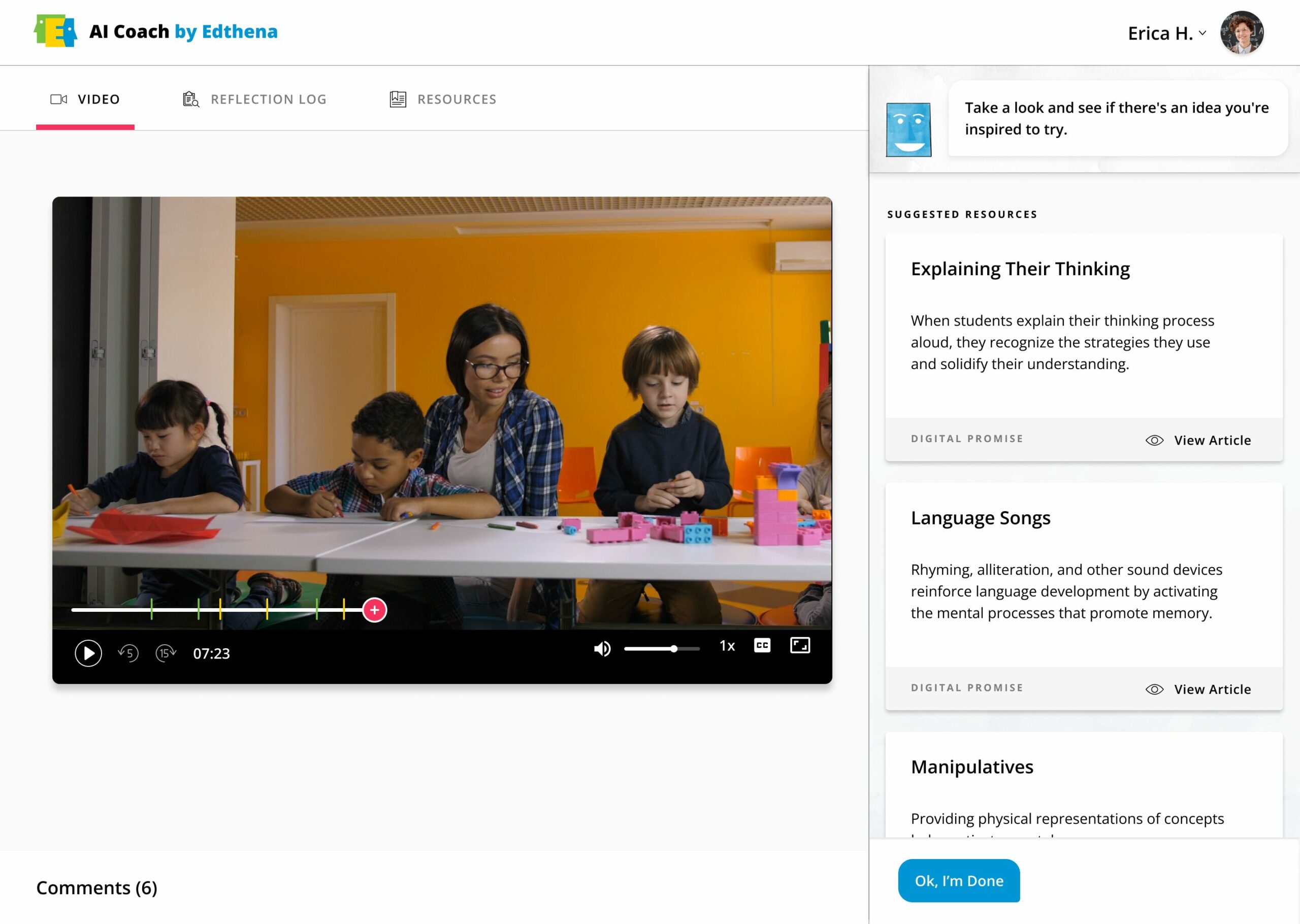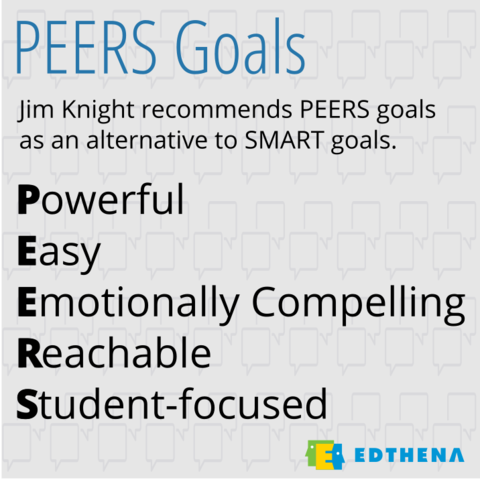Jim Knight Explains the Impact Cycle & PEERS Goals
According to Jim Knight, author of The Impact Cycle, “video is the most powerful tool for professional development … except for maybe the computer and the internet.” But why? And how does this structure called the Impact Cycle help to make it so effective?
One reason is that video offers teachers a “clear picture of current reality.” According to Knight, other attempts to provide teachers with feedback fail in this regard. As a result, educators are surprised to see the reality of their instruction when presented with video evidence.
Jim Knight presented alongside Adam Geller, author of Evidence of Practice, at the Learning Forward Annual Conference. During his talk, Knight explained:
- The impact of video on instructional coaching
- Video’s place within the Impact Cycle
- The way that video transforms teacher goal-setting
Moving from a culture of talk to a culture of action
Knight notes that video has the power to move education from “a culture of talk to a culture of action.” According to Jim Knight, schools are prone to accept the status quo, and discuss changes but never actually implement them. Video changes this by delivering the “clear picture of current reality” to discuss.
“When you push the red button you’re gonna do something,” Knight says. In other words, teachers can’t deny the areas for improvement when they see them on video. It spurs them to take action and make change.
Equally as powerful is the way that video transforms the relationship between teacher and instructional coach. No longer is the coach responsible for telling the teacher what happened. Instead, the video shows it. The coach is there to discuss the results and offer support.
Knight sees video as transformational for professional development, akin to how Napster and iTunes revolutionized music. Further, video for PD is a new technology. There are still underexplored possibilities, such as video libraries of best teaching practices.
What is the Impact Cycle in schools?
Jim Knight’s Impact Cycle is a three-stage process designed to help instructional coaches collaborate with teachers to set development goals that align with classroom needs. The ultimate aim is to enhance instructional practices and improve student outcomes.
The Impact Cycle emphasizes strong partnerships between coaches and teachers. This framework supports setting clear coaching goals, planning effective strategies, and monitoring progress to achieve measurable impact. Instructional coaches utilize tools such as video analysis and case studies to foster clarity and proactive problem-solving.
The process includes systematic data collection and deep listening practices to ensure comprehensive teacher development. By combining technology, such as video analysis, with coach-teacher interactions, the approach ensures well-rounded support for teachers, ultimately enhancing educational outcomes.
What are the steps of the Impact Cycle?
The Impact Cycle has three stages: identify, learn, improve. We outline each stage below and how they work together to create a structured support model for enhancing teaching performance.

Identify stage of the Impact Cycle
During the Identify stage, the focus for the teacher is on setting clear, achievable goals based on a clear understanding of their current classroom realities.
Video plays an important role in the Identify stage. The teacher, supported by their coach, views a video of their teaching. They deeply analyze what’s truly happening within the learning environment to determine areas for growth. Using this data, the next step is for the teacher to set a goal known as a PEERS goal (see section below).
Questions that might be asked during the Identify stage include:
- What are the current strengths and areas for growth in teaching practices?
- What specific goals can we set to address these areas?
- How will we measure progress toward these goals?
Learn stage of the Impact Cycle
In the Learn stage, the teacher partners with the coach to learn strategies for achieving their near-term goal. This stage may include accessing a library of best practices, modeling by the coach, or viewing videos of strategies in action.
Questions that might be asked during the Learn stage include:
- What resources or training are available to address our goals?
- What evidence-based strategies can be applied in the classroom?
- How can we ensure these strategies are implemented effectively?
Improve stage of the Impact Cycle
In the Improve stage, the teacher implements their new strategy and evaluates the impact on student learning. The goal is to assess impact and make further adjustments as needed until the goal is achieved.
Gathering new data is a keystone of this stage of the cycle. Video can be a valuable tool for gathering new data about impacts on student learning.
Bottom line, the process requires evidence to measure progress toward achieving the PEERS goals. This stage emphasizes continuous improvement and adaptability.
Questions that might be asked during the Improve stage include:
- How are the new strategies impacting student learning and engagement?
- What feedback have we received, and how can it inform further adjustments?
- What additional support or resources are needed to enhance effectiveness?
These three stages offer a structured approach to instructional coaching, ensuring focused, data-driven improvements in teaching practices.
How AI Coach helps educators implement the Jim Knight Impact Cycle
Collaborative 1:1 coaching is critical in helping educators implement the Impact Cycle. However, in-person coaching is limited to the amount of coaches and time available to reach teachers.
The AI Coach platform provides a way for teachers to learn on their own using the Impact Cycle method. This ensures teachers can continue their growth between formal coaching sessions.
In the platform, teachers partner with a virtual coach for the full self-reflection, action-planning, and data-collection aspects of the Impact Cycle. They set classroom-level goals based on data from their classrooms, learn and implement new strategies to help achieve their goal, and adjust their approach based on the observed impacts.
One added benefit is that teachers can work through cycles at their own pace, pausing and resuming coaching sessions on demand.
Let’s look at how teachers can implement the Impact Cycle in the platform.

Implementing the Identify stage of the Impact Cycle with AI Coach
In the Identify stage, the teacher develops clear, achievable goals based on their current performance.
During this stage, uploads a video for self-observation and self-reflection. In conversation with the virtual coach, the teacher identifies their current priorities (e.g. improving checks for student understanding, more robust differentiation, Science of Reading-based literacy methods). The virtual coach provides customized reflection questions to help the teacher gather evidence from within their teaching video. The purpose is to focus on strengths and areas for improvement. Uploaded videos are secure and private only to the teacher, which mirrors the privacy of a more traditional coaching process.
After reviewing the video evidence, teachers work with the virtual coach to summarize their observations and set a near-term goal that follows the PEERS goal-setting style.
Implementing the Learn stage of the Impact Cycle with AI Coach

In the Learn stage, teachers discover new ideas and strategies to implement based on their established goal.
During this stage, the virtual coach provides access to hundreds of high-quality, curated resources, enabling teachers to learn new strategies for their classroom. Each of the strategies is specifically aligned to the goal area of the teacher.
This process results in a personalized action plan tailored to the teacher’s goals. With this plan, the teacher returns to their classroom to implement the newly learned strategies within a new lesson and to gather data about progress toward their goal.
Implementing the Improve stage of the Impact Cycle with AI Coach
In the Improve stage, the teacher evaluates the impact of their changes on student learning. They’ve implemented the new strategy and gathered data. Now it’s time to assess their improvement.
During this stage, the virtual coach supports teachers in analyzing their performance data. Based on the evidence collected, the teacher works with the virtual coach to determine implications for future action.
After completing the coaching cycle, the virtual coach provides teachers with a PDF of their reflection log. This document is a useful artifact to support future in-person coaching conversations.
Teachers can complete as many coaching cycles as they like, allowing them to tailor their learning and goals as new observations are made.
Fostering teacher buy-in with PEERS Goals
In order to create meaningful goals during coaching sessions, Knight suggests teachers and instructional coaches discuss these questions:
- On a scale of 1-10, how close is the lesson to your ideal?
- What pleased you about the lesson?
- How would you have changed it to make it closer to a 10?
- What would you see your students doing differently?
- Describe what that would look like.
- How could we measure that?
- Should that be your goal?
- If you could reach that goal would it really matter to you?
- What teaching strategy would you like to try to achieve your goal?
The discussion resulting from these questions helps coaches and teachers reliably create PEERS goals. This style of goal bears some resemblance to the popular SMART goal, but it contains a few specifics that make it especially relevant and useful for the instructional coach/teacher relationship.

PEERS goals are:
- Powerful – Teachers should select a goal that, if achieved, will make a real difference in students’ lives.
- Easy – In this case, “easy” does not mean the goal can be achieved with little effort. Instead, it means the goal is simple instead of unnecessarily complex.
- Emotionally-compelling – The teacher should care deeply about the goal. Video helps here. When teachers identify areas of instruction needing improvement, they are more likely to select personally meaningful goals.
- Reachable – This implies the goal can be measured, and the goal can be reached using a specific instructional strategy.
- Student-focused – A focus on students ensures reaching goals will result in improved learning outcomes for students. Teacher-focused goals may sound nice but may not be directly connected to student learning. For example, a teacher might set a goal to “integrate more technology into instruction.” It’s difficult, though, to know if the goal actually helped students learn more.
An example PEERS goal might be get 85% of the class authentically engaged using an instructional strategy of encouraging higher-level questioning.
By discussing lesson videos in a structured way, teachers see the “clear picture of current reality.” This compels them to set meaningful goals to improve student learning.
Ready to implement the Impact Cycle in your district? We’re here to help! Contact us today to get started.

